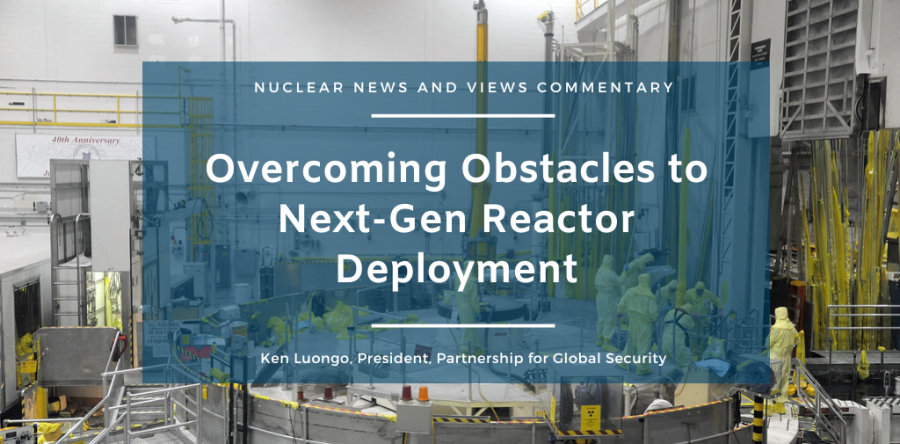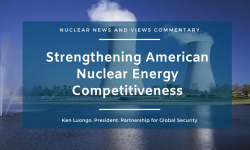A meeting in Austin this month crystalized a growing concern about whether the U.S. has an effective strategy for actually deploying the next generation of smaller nuclear reactors into which it is pouring billions of dollars in technology development.
The key insight into the dilemma was offered by a senior official from the Department of Energy’s clean energy loan program. She stated, “The industry is stuck in a stalemate, where utilities are staring at reactor developers, reactor developers are staring at the suppliers, and no one is ready to move or make real capital decisions about building new nuclear.”
This statement is consistent with the March 2023 DoE report on “Pathways to Commercial Liftoff: Advanced Nuclear.” That report also makes clear that beyond the stare-off between the reactor developers and utilities, there are other serious challenges facing advanced nuclear power commercialization.
These include creating a committed order book for one or a few reactors under development, reinvigorating the industrial supply chain for nuclear power, creating fuel for these reactors, and streamlining the licensing process.
On the licensing issue, there is at the moment another kind of impasse.
The Congress passed legislation requiring the NRC to develop a streamlined licensing process for advanced reactors that was signed into law. The result of that mandate was Part 53, described as a “Risk Informed, Technology Inclusive Regulatory Framework for Advanced Reactors.”
Except maybe it isn’t.
A subcommittee of the House Energy and Commerce Committee convened a hearing this week with the chairman and commissioners of the NRC to assess “Efficient and Predictable Nuclear Safety Regulation.” During the testimony, one commissioner said, “I’m struggling a bit with the nature of the…draft [regulatory] proposal that the vast majority of the industry considers unworkable.”
The inability to reform the NRC regulatory review could prove a major setback to the deployment of the “hundreds…maybe thousands of nuclear facilities here in the United States” that at least one congressman thinks is the objective of the government’s investment.
The frustration is not limited to the NRC. It also has taken aim at the DoE approach to developing nuclear fuel for the next-generation of reactors.
The high-assay low-enriched uranium (HALEU) fuel that many advanced reactors need to run on is not available for commercial purchase from an American company. This fuel enables smaller reactors to produce more power and run for longer periods. The fuel is available from Russia. But because it has become an international pariah as a result of its invasion of Ukraine, leading companies like TerraPower will not purchase the Russian product even though that will delay its reactor deployment by at least two years.
DoE is trying to remedy the scarcity of HALEU by responding to a congressional mandate that domestic uranium enrichment be restarted. The centerpiece of the effort is the reconstitution of the uranium enrichment plant in Piketon, Ohio and DoE has entered into a $150 million cost share contract to produce the fuel.
But the HALEU production will start slowly with a goal of 20 kilograms by the end of this year. Full production is likely years away and it is estimated that “more than 40 metric tons of HALEU will be needed before the end of the decade.” This has given rise to criticism about whether DoE can actually produce the needed quantities for the reactor demonstrations into which the Congress has poured taxpayer dollars and whether it can support extensive reactor deployment.
Beyond the domestic needs of HALEU and the potential deployment of small reactors on U.S. territory, is the importance of developing export markets for American peaceful nuclear technology.
Here again, the Congress has taken the lead in pushing for the ascension of the U.S. as a major nuclear exporter.
A new bipartisan Senate bill offers enhanced “financing tools” within the Export-Import Bank that will enable U.S. companies to better compete with the reactor packages of Russia and China. That is essential because as bill co-sponsor, Senator Jim Risch, noted, “If we allow Russia and China to dominate the nuclear energy field, it will be nearly impossible to undo.”
There is little doubt that an enhanced financing package that links the U.S. government with private companies in this battle for market share is necessary. Russia and China both underwrite their state-owned companies export activities, as noted by the bill’s other co-sponsor, Senator Joe Manchin, and they use that leverage for commercial and geopolitical purposes.
However, even if this legislation becomes law, there still is a glaring gap in the approach that the U.S. and allied nations are taking to prepare developing economy nations to actually purchase and use these small nuclear reactors.
U.S. efforts to prepare nations for small reactors are remarkably spare and incremental, focused on capacity building in nations with little indigenous capacity to be expanded. Little focus has been given to a concept that would allow licensed U.S. and allied operators to run reactors in third countries while the indigenous capability is developed. But that’s what may be necessary to help ensure market share.
The alternative is the IAEA’s laborious Milestones approach that is designed for the deployment of large, not small, reactors and requires at least a 10 year commitment from countries.
These regulatory, fuel, and export issues, which can be showstoppers for next-gen reactors are creating pressure and pointed policy recommendations from civil society to get the ball moving faster. If these matters continue to fester because of ineffective integration, strategy, and discipline within the Biden administration, there will be a backlash from both sides of the aisle.
The next two years are critical for laying down the policy framework for nuclear power in its new context as a carbon reduction technology and energy security spearhead.
Despite the abysmal nature of America’s political warfare, the climate change and geopolitical roles of nuclear energy are bipartisan priorities. As the American Nuclear Society has underscored, failure is not an option. Unfortunately, at the moment it is a possibility.
Ken Luongo, President, Partnership for Global Security




